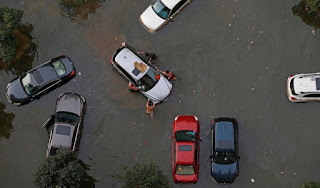“Impossible” is a fraught word, but a new set of studies concludes that at least three atmospheric and oceanic phenomena from 2016 wouldn’t have occurred had we not been adding greenhouse gases to the air for more than a century.
Record heat in Asia, record-high global temperature, and a marine “heat wave” in the far North Pacific are among 27 events analyzed in Explaining Extreme Events in 2016 from a Climate Perspective. This report, free to download in its entirety, is the sixth annual compilation of climate attribution studies published as a supplement to the Bulletin of the American Meteorological Society (BAMS). The 2016 report was released on Wednesday.
The BAMS series has become the leading venue for papers in the climate-science subfield called detection and attribution (D&A). The idea in such work is to identify a measurable weather/climate change (detection) and to determine what caused it (attribution). Most D&A studies end up yielding probabilities, typically the extent to which odds of a given event have been raised by climate change. This year, the BAMS report includes three events that go so far beyond any modern precedent that they can’t be explained without invoking human-produced greenhouse gases.
"This report marks a fundamental change," said Jeff Rosenfeld, editor-in-chief of BAMS. “For years scientists have known humans are changing the risk of some extremes. But finding multiple extreme events that weren’t even possible without human influence makes clear that we're experiencing new weather because we've made a new climate."
Read more at Three Things that Wouldn't Have Happened in 2016 Without Climate Change

No comments:
Post a Comment